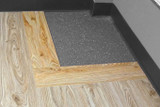Waterproof Vinyl Flooring vs. Cat Pee

In a comment on our post about Loose Lay Waterproof Vinyl Planks, Angela asked some good questions, and I wanted to include illustrations with our answers.
Hi, this product says “very durable” but I have specific concerns for whatever I lay down and wonder if this really is tough enough. It’d be for our basement where we have a home business with two desks.
1. We have an older cat with bladder problems that has a favorite corner to pee in the office. That corner is carpet and the immediate reason we’ve got to redo the flooring. Cat urine is strong stuff, and while I don’t intend to let it sit, if it’s in one spot repeatedly will I need to worry about staining, or it leaking between the planks? They look tight; they will allow me to clean under easily if needed but I’d prefer not to need to of course.
The Loose Lay Vinyl is extremely stain resistant, and we stand by that, but to be honest, we've never tested cat urine ourselves here. We don't have any. The manufacturers generally test for household chemicals, and other common spillables like red wine (that's a big one, actually). This is a cautious 'yes'.
As for leakage, I can say that the Loose Lay planks are designed to fit together quite snugly, especially the tops of the planks. Take a look.
See how they're cut? There is a slight angle to the factory edges so that the tops really push together nice and tight.
But even with that, they can probably only keep liquid from seeping between for a while, maybe a couple of hours depending on how they're installed. Eventually it probably would leak through and then, yes, you could clean it easily because these planks pull right up. They're kept in place by gravity, not nails or glue. The planks themselves are waterproof, impervious to damage from the urine, but even as well as they meet, we can't say that they make your subfloor waterproof. It's the nature of anything pieced together - eventually water can get through.
Since you are replacing your floor, you might consider, just for that corner area, removing your existing flooring all the way to the cement. There are cement sealants you could find which would keep any existing, soaked in urine smell from continuing to affect the room, and also any new stuff from soaking back down. It would stay on top. This could make lifting the planks and cleaning a little easier - OR you could go even further and take advantage of the fact that these planks don't have to connect. As shown below, you could define an area, leaving the treated cement uncovered, eliminating at least one step in the cleaning process.

You see, they don't have to be laid all in the same direction, so you can lay out borders or, in your case, create a space for the inevitable.
2. The office chairs have been VERY hard on the laminate we’d laid down. I’m afraid nothing will be tough enough except tile, but we don’t want the grout line bumps which will be annoying for rolling chairs.
Laminate has ratings called AC ratings. On a scale from 1-5, floors rating up to 3 are for residential uses, while those in the 4-5 range are considered commercial laminates, and *should* handle your chairs. An AC3 rated laminate might not, as that isn't standard residential traffic, so the tests at that level don't go that far.
Among all the floors designed to look like wood planks, laminate, vinyl and actual hardwood, the toughest surface available is still found on laminate, even at that middle AC3 level. For example, because of the aluminum oxide coating, laminate can handle high heels where no hardwood, even the toughest, should be walked over with those.
Now, you have a live test right in your basement that tells you laminate has had an issue with your chairs. This means that your chairs would be even harder on the Loose Lay Vinyl. The solution for any of these plank options would be to use an office floor mat designed for rolling chairs. You're right that a lot of stone tiling would handle the furniture traffic, and also right that the grout lines would be hard on (possibly eventually wear out) the rollers. Even there you would probably want the mat, if just to smooth out the ride.
So far, just considering the office chairs, your best bets would be:
1. Poured concrete (crazy expensive, and a proper construction activity)
2. An office mat over any laminate, vinyl plank or stone tiles. It sounds like a mat is almost a necessity. The down side is that you can't zoom backwards all the way across the room from desk to desk (unless you get a huge one), but the upside is that if you use one, your flooring options are all equal as far as the chairs go.
3. I can't imagine this being the most appealing option, given your experience, but if you can determine the AC rating of your old laminate, and if it was 3 or lower, you could go at least 1 level higher, making sure to fall into AC ratings of 4 or 5 and try a tougher laminate. For a smooth, uncovered floor, that may be your only possibility.
3) One last question- under the carpet is glued on tile, I’m assuming the floor will need to be extremely smooth and flat for the loose lay planks, right?
Yes and no.
YES, VERY FLAT: For any of the plank styles of flooring, if they can be laid over existing flooring (and most can be) whatever they go over must be flat. To be very general, just so you can get an idea of your situation, you don't want a change of more than 3/8" over any 10 foot span. So the floor could slope down only, or up only, by 1/8 of an inch in 10 or more feet and you would be okay. That figure is specific to the type you get (laminate or vinyl, for instance) and even the brand, so you would need to check the documentation for an exact number.
NO, NOT SO MUCH: It can be okay if the tile underneath has a bumpy surface, rather than a slick, sock-slidable, marble-like sheen. That will work fine. These can go over plywood, so most floor tiles should work quite well under the Loose Lay.
Thanks for you expertise, I am extremely impressed by the personal replies to to the comments.
Thank you for the compliment! Now I hope I have measured up to it, and offered some advice that has really helped you out. Thanks yourself. These were really good questions, and I'll bet others have wondered about them too.
If you have more questions, or more specific ones, give us a call!
– – – –
David has written and made videos about flooring products and installation since 2011 at Floors To Your Home (.com), where he is also the PPC Manager, a Researcher, a Website & Marketing Strategy Team member, Videographer, Social Strategist, Photographer and all around Resource Jito. In my spare time I shoot and edit video, put together a podcast, explore film history, and mix music (as in ‘play with Beatles multi-tracks’). Connect with
W. David Lichty
Follow Team Floors To Your Home on Facebook

 Brown Tone
Brown Tone
 Red Tone
Red Tone
 Golden Tone
Golden Tone
 Gray Tone
Gray Tone
 Light Tone
Light Tone
 Medium Tone
Medium Tone
 Dark Tone
Dark Tone
 Multi Color
Multi Color
